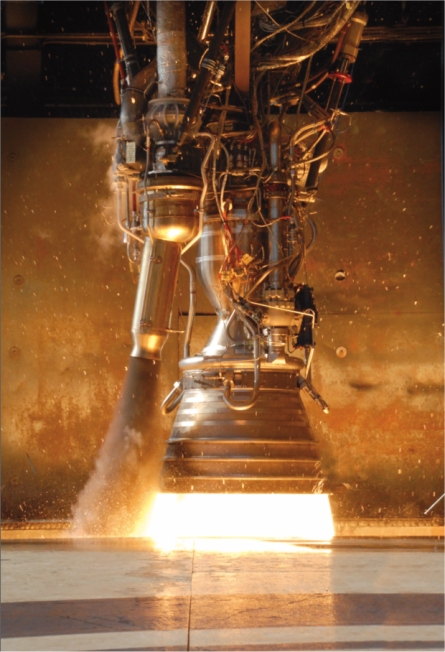SpaceX has completed testing of its latest Merlin rocket engine in preparation for a Falcon 1 launch in the first quarter of 2008. The kerosene-fuelled Merlin 1C is an improved, regeneratively cooled version of the Merlin 1A ablatively cooled engine that powered the first two Falcon 1 launch vehicle flights in March 2006 and March 2007.
An array of nine Merlin 1Cs on the first stage and one on the second will power SpaceX's much larger Falcon 9 rocket, which it hopes to operate for NASA as an International Space Station resupply launch vehicle. SpaceX is the frontrunner in NASA's Commercial Orbital Transportation Services (COTS) competition to develop ISS resupply capabilities for use after the Space Shuttle is retired in 2010.
The next Falcon 1 launch, from the company's launch complex in the Pacific atoll of Kwajalein, has no payload scheduled, but will fly regardless. "The most important thing is to demonstrate our capability," says SpaceX.
The El Segundo, California-based company says its COTS preparations are on schedule, with a Falcon 9 demonstration flight planned for the fourth quarter of 2008. The Falcon 9 launch vehicle and its Dragon cargo capsule passed their critical design review in August. The Dragon is designed to carry cargo or up to seven crew.
Earlier in November SpaceX broke ground for its Falcon 9 launch site at Launch Complex 40 at Cape Canaveral, Florida. The site will be capable of supporting both Falcon 9 and Falcon 9 Heavy missions.
|
|---|
The final test was a 170s firing |
The Merlin 1C uses RP-1 kerosene to first cool the combustion chamber and nozzle before being burned with liquid oxygen and to create thrust. This regenerative cooling provides higher performance without significantly increasing engine weight, says SpaceX vice-president Tom Mueller.
"We performed the final test in the development series, a 170s-long mission duty firing. This series of runs has verified the final design features," he says, adding that total run time on the engine exceeded 3,000s across 125 hot-fire tests.
In its Falcon 9 first-stage configuration, the Merlin IC has a sea-level thrust of 95,000lb (423kN) and a vacuum thrust of more than 108,000lb, vacuum specific impulse of 304s and sea-level thrust-to-weight ratio of 92:1. The Merlin consumes 160kg/s (350lb/s) of propellant and the chamber and nozzle, cooled by 45kg/s of kerosene, are capable of absorbing 10MW of heat energy. A planned turbopump upgrade in 2009 will increase thrust by more than 20% and thrust-to-weight ratio by around 25%.
The Falcon 9 will be able to launch 5,070kg to geostationary orbit from Kwajalein and 4,900kg from Cape Canaveral. The planned Heavy version could place 12,000kg into geosynchronous transfer orbit.
According to SpaceX, the Merlin engine is the first new US booster engine in 10 years and only the second in more than 25 years. The previous two US engines were the RS-68 developed in the late 1990s by Rocketdyne for the Boeing Delta IV launch vehicle, and the Space Shuttle Main Engine developed in the late 1970s, also by Rocketdyne, which is now part of Pratt & Whitney.
Source: Flight International

















